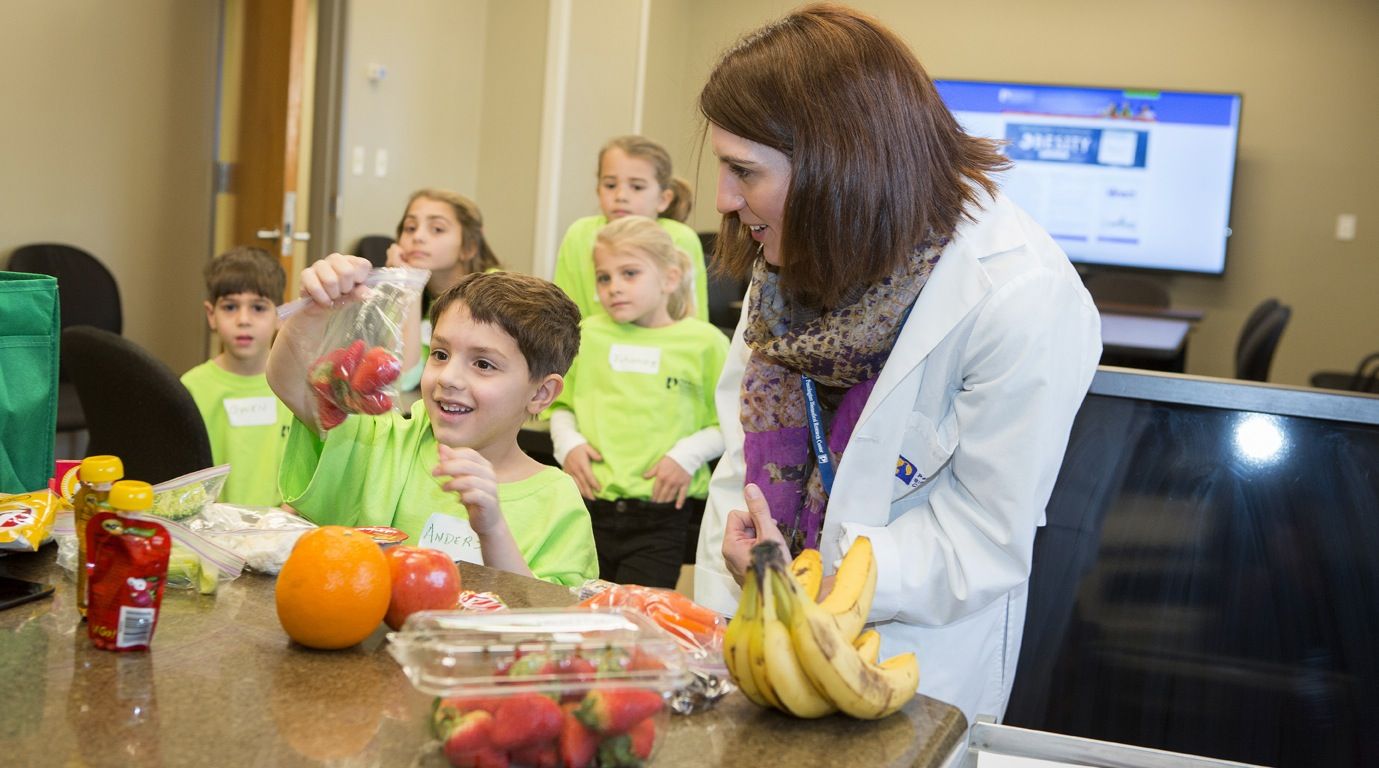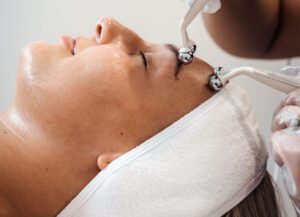Weighty issues
Kate Blumberg, a dietitian in Pennington’s Dietary Assessment and Nutrition Counseling department, instructs children during “Our Lifestyles, Our Lives”— a program that the center produces with Our Lady of the Lake Hospital. It teaches parents and children how to make healthy choices when planning and preparing meals and even includes field trips to the grocery store for real-world coaching.
Pennington’s kid-focused clinic finds fun ways to tackle the obesity trend
By now, many New Year’s resolutions of weight loss and healthy living have gone by the wayside thanks to a decadent Mardi Gras season, weak resolve or poor planning. And it’s no help that many festivities in south Louisiana revolve around food and drink. Long-term weight loss here is hard.
But after 20 years of intense study, researchers and physicians know how to help adults lose weight. And it’s no big secret. Winning the battle of the bulge requires adhering to tried-and-true behavioral modifications in exercise and diet.
But while researchers have focused on satisfying the demand for adult weight-loss solutions, the percentage of children and adolescents classified as obese and overweight has quietly crept up to 32% nationally and 50% statewide. “That’s a dramatic rise in the past 30 or 40 years,” says Pennington Biomedical Research Center Associate Professor Corby Martin. “In the early ’70s, that number was about 5%.”
An early onset of unhealthy weight gain increases the probability a child will develop into an obese adolescent and adult. Overweight kids also have an increased risk of diabetes, hypertension and lipid imbalances, which take a tremendous toll on their bodies and can potentially shorten their lifespans.
With that in mind, PBRC invested $6.4 million from the state of Louisiana to renovate a 14,000-square-foot clinic into the Translational Research Clinic for Children (TReCC). Opened in January 2014, the new facility houses a cluster of labs, high-tech exercise studios and demonstration kitchens that comprise the Childhood Obesity and Diabetes Research Program.

“We have a 25-year history of working in obesity and bio medicine research in adults,” says PBRC Associate Executive Director Peter Katzmarzyk. “We are now able to bring all of our resources [to bear] on the problems of child obesity, really focusing on physical inactivity and healthy diets as well as any other kinds of clinical studies.”
While the clinical trials are created in the Capital City, Katzmarzyk intends for TReCC to become a statewide hub. By collaborating with the LSU AgCenter extension service in every parish, he hopes to disseminate TReCC programs as far as West Carroll Parish and to other remote areas across the state.
One of the first studies to take advantage of the state-of-the-art space was dubbed Klub Kinect. The study sought to determine the potential of a 12-week exer-gaming dance program to improve the health of overweight adolescent girls.
“We couldn’t have done this study, the way we did it, without TReCC,” Assistant Professor Amanda Staiano says. “TReCC provided a comfortable, separate space just for children, teenagers and their families with child-friendly equipment, decor and even toys. It had the space we needed to have 10 or 12 girls exercising at one time. ”
While TV remains the king of screen activities, video games also keep teenagers on the couch. “We’re trying to meet children and teens where they are—to work with their interests and the technology to improve fitness,” Staiano explains.
Rather than simply allowing the kids to use technology to exercise in isolation, Klub Kinect built upon teenagers’ innate desire to engage in activities with their friends.
“What was important is they were playing with other girls in the program,” Staiano says. “So it was really a social sort of after-school class, where they could come in and play games. And they were dancing the whole time.”
The data is still being analyzed, but Staiano says one big achievement was simply getting 42 busy high-school students to come to TReCC several times a week for three months. Staiano believes the girls’ commitment and enthusiasm was an indication that they really enjoyed the program.

Kayla Bullard certainly did. When Bullard’s grandmother saw the call for Klub Kinect participants in a PBRC email, she mentioned the study to the 15-year-old, who was eager to try it.
“I thought it sounded entertaining,” says Bullard with a laugh. “I can’t dance, [so] I thought I would try to get better at it.”
While the Lee Magnet High School freshman describes herself as a lazy person who “likes the couch,” she is active in her school’s plays and color guard as well as church activities. But when she began the study in spring 2014, exercise was not a priority. That changed quickly. “[The program] was not something you would dread,” Bullard says. “It was a really good environment. Everyone was really friendly. It didn’t feel like you’re exercising. You’re having fun with other people, and you’re enjoying yourself. I made a lot of really good friends, and I still keep in touch with them.”
Bullard believes she lost between five and 10 pounds during the study. In addition to weight, researchers measured body fat, blood pressure and biomarkers such as cholesterol and glucose levels. They also scrutinized changes in the girls’ self-confidence related to physical activity, outside physical activity and friendships/peer support.
“The exer-gaming participants reported more physical activity and more confidence related to exercise,” says Staiano.
Since the study ended, Bullard missed the program so much that she actually invested in a home version.
“I bought a Just Dance 2014 game so I can start dancing at home,” she says. “The exer-gaming is something anybody could enjoy. My grandmother wants to do it now.”
Not only are researchers working with teenagers, they now are attacking the problem in the early years. Recently, principal investigator Martin launched the DRIVE study, a training program targeted to toddlers and their parents.
The goal is to help overweight two- to five-year-old children establish a healthy body mass by working with their parents to improve the children’s health through positive interactions.
Rather than requiring parents and toddlers to come to TReCC, researchers travel to the participants’ homes for training sessions. TReCC professionals aim to help parents identify opportunities and better manage behaviors and daily issues—such as post-work inertia or the classic before-dinner cookie meltdown—that can sabotage healthy eating and exercise.
“[The home visits] allow us to make a much more positive impact with the parents [in] their interaction with their children and the children’s health,” Martin says. “If we can instill these behaviors early on, they will carry forward, and we’ll have a much better chance of affecting body mass over the long term.”
If that comes to pass, Louisianans—and other Americans—can check weight loss off their New Year’s resolution list in years to come.












